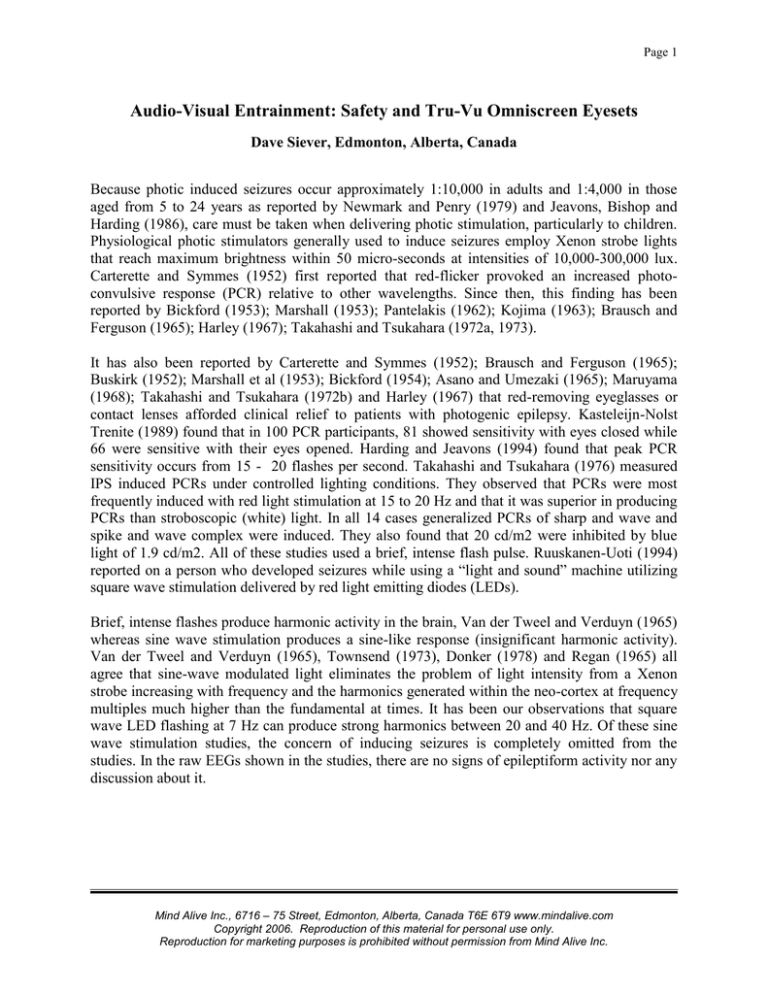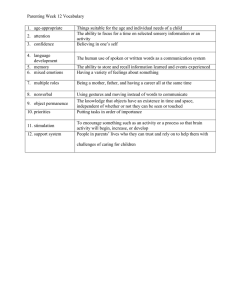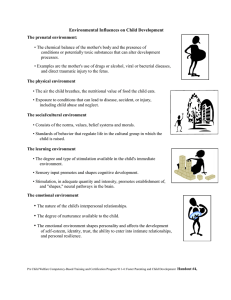Clinical reports of flicker stimulation go as far back as the early
advertisement

Page 1 Audio-Visual Entrainment: Safety and Tru-Vu Omniscreen Eyesets Dave Siever, Edmonton, Alberta, Canada Because photic induced seizures occur approximately 1:10,000 in adults and 1:4,000 in those aged from 5 to 24 years as reported by Newmark and Penry (1979) and Jeavons, Bishop and Harding (1986), care must be taken when delivering photic stimulation, particularly to children. Physiological photic stimulators generally used to induce seizures employ Xenon strobe lights that reach maximum brightness within 50 micro-seconds at intensities of 10,000-300,000 lux. Carterette and Symmes (1952) first reported that red-flicker provoked an increased photoconvulsive response (PCR) relative to other wavelengths. Since then, this finding has been reported by Bickford (1953); Marshall (1953); Pantelakis (1962); Kojima (1963); Brausch and Ferguson (1965); Harley (1967); Takahashi and Tsukahara (1972a, 1973). It has also been reported by Carterette and Symmes (1952); Brausch and Ferguson (1965); Buskirk (1952); Marshall et al (1953); Bickford (1954); Asano and Umezaki (1965); Maruyama (1968); Takahashi and Tsukahara (1972b) and Harley (1967) that red-removing eyeglasses or contact lenses afforded clinical relief to patients with photogenic epilepsy. Kasteleijn-Nolst Trenite (1989) found that in 100 PCR participants, 81 showed sensitivity with eyes closed while 66 were sensitive with their eyes opened. Harding and Jeavons (1994) found that peak PCR sensitivity occurs from 15 - 20 flashes per second. Takahashi and Tsukahara (1976) measured IPS induced PCRs under controlled lighting conditions. They observed that PCRs were most frequently induced with red light stimulation at 15 to 20 Hz and that it was superior in producing PCRs than stroboscopic (white) light. In all 14 cases generalized PCRs of sharp and wave and spike and wave complex were induced. They also found that 20 cd/m2 were inhibited by blue light of 1.9 cd/m2. All of these studies used a brief, intense flash pulse. Ruuskanen-Uoti (1994) reported on a person who developed seizures while using a “light and sound” machine utilizing square wave stimulation delivered by red light emitting diodes (LEDs). Brief, intense flashes produce harmonic activity in the brain, Van der Tweel and Verduyn (1965) whereas sine wave stimulation produces a sine-like response (insignificant harmonic activity). Van der Tweel and Verduyn (1965), Townsend (1973), Donker (1978) and Regan (1965) all agree that sine-wave modulated light eliminates the problem of light intensity from a Xenon strobe increasing with frequency and the harmonics generated within the neo-cortex at frequency multiples much higher than the fundamental at times. It has been our observations that square wave LED flashing at 7 Hz can produce strong harmonics between 20 and 40 Hz. Of these sine wave stimulation studies, the concern of inducing seizures is completely omitted from the studies. In the raw EEGs shown in the studies, there are no signs of epileptiform activity nor any discussion about it. Mind Alive Inc., 6716 – 75 Street, Edmonton, Alberta, Canada T6E 6T9 www.mindalive.com Copyright 2006. Reproduction of this material for personal use only. Reproduction for marketing purposes is prohibited without permission from Mind Alive Inc. Page 2 The Advantage of Tru-Vu Omniscreen Eyesets There are many manufacturers of eyesets who have not taken proper care in design to ensure safety. Some of these eyesets create problems because: 1) 2) 3) 4) 5) they use square wave stimulation. many use red LEDs. the LEDs stick out into the eyes with intense, foveal (middle of visual field) stimulation. they use clear encase LEDs and/or they use whole eye stimulation rather than field stimulation. At Mind Alive Inc., we have taken precautions to ensure that your AVE experience is not only enjoyable, but safe. 1) To address the concerns of eliciting a photic induced seizure, the Omniscreen eyesets used with the DAVID Paradise XL systems have a slowed turn-on and-off time of about 15 msec. The waveform from our DAVID Pal system uses sine wave stimulation for frequencies from 10 and below. As mentioned, sine wave stimulation has been shown NOT to produce seizures. Square wave stimulation from other systems produces a harmonic at 3 times the stimulation frequency. What this means is that 10 Hz alpha (meditation) stimulation will often generate a 30 Hz (anxiety producing) brain wave in the user. What’s worse is that people who are prone to anxiety are most susceptible to having an anxiety or panic reaction to square wave stimulation. These manufacturers use square wave stimulation because it is easy and cheap to generate from microcomputer ports used in their systems. Sine wave stimulation used in the DAVID Pal doesn’t produce the harmonics that square wave stimulation does and will not produce entrainment-induced anxiety while stimulating in the alpha and theta ranges. 2) As is indicated in the research, the red light emitted from some of these eyesets increases the chance of having a seizure. Our in-house studies also show that red and orange color stimulation blocks the relaxation process that entrainment is attempting to obtain. This is why we tint the overlays a light blue in DAVID Paradise XL which uses incandescent bulbs and use blue-tinted white LEDs in our DAVID Pals. 3) The foveal stimulation of these other eyesets and lightframes stimulates only about 1/3 of a square inch of visual field, which makes a bright spot in the middle of the user’s vision. Because our eyes roll about somewhat when they are closed, this bright spot “bounces” about in the user’s visual field. Because our brains are made to detect change, this constantly moving bright spot triggers the brain to constantly become alert in response to what it thinks is new stimulation, which in turn destroys the meditative, relaxed state the user is trying to get into in the first place. The Omniscreen eyesets illuminate a full 2 square inches per eye, which provides smooth, even illumination, meaning that as the eyes roll about, the brain won’t perceive any changes significant enough to alert it. 4) LEDs produce laser light. Many of these other eyeserts use LEDs encased in clear plastic. According to tests done at the Alberta Laser Institute, these LEDs can actually burn the retinas of Mind Alive Inc., 6716 – 75 Street, Edmonton, Alberta, Canada T6E 6T9 www.mindalive.com Copyright 2006. Reproduction of this material for personal use only. Reproduction for marketing purposes is prohibited without permission from Mind Alive Inc. Page 3 the user’s eyes if accidentally used with their eyes open, regardless of the color emitted from the LED. In the Omniscreen eyesets, the protective overlay in front of the LEDs break up the light, rendering them completely safe to use. 5) Stimulation alternating back and forth from the left and right eyes is very dissociating and frequently makes people nauseous, in part because this type of stimulation generates a “mishmash” of disorganized frequency responses within the brain. Our TruVu eyesets utilize split field stimulation, which is far less likely to produce nausea. TruVu stimulation also allows a different frequency to be stimulated into each side of the brain, which is essential for treating certain conditions such as depression, ADD and cognitive decline in seniors. We hold the patent on separate field stimulation and have licensed this technique to one competitor. References Asano, T., Umezaki. (1965). Photogenic epilepsy-presentation of case (in Japanese). Clinical Neurology, Vol 5, 519-523. Bickford, R., Daly, D., and Keith, H.M., (1953). Convulsive effects of light stimulation in children. American Journal of Diseases of Children, 86,170-183 Bickford, R. (1954). Sensory precipitation of seizure. Journal of Michigan Medical Society, Vol 53, 1018-1020 Brausch, C., and Ferguson, J. (1965) Color as a factor in light-sensitive epilepsy. Neurology, 15,154-164. Buskirk, C., Casby, J., Passouant, P. and Schwab, R. (1952). The effect of sifferent modalities of light on the activation of the eeg. Electroencephalography and Clinical Neurophysiology, 4, 244-245. Carterette, E. C. & Symmes, D. (1952). Symposium: photo-metrazol activation of electroencephalogram; color as experimental variable in photic stimulation. Electroencephalography and. Clinical. Neurophysiology, 4, 289-296. Donker, D., Njio, L., Storm Van Leeuwen, W., and Wieneke, G. (1978). Interhemispheric relationships of responses to sine wave modulated light in normal subjects and patients. EEG and Clinical Neurophysiology, 44, 479-489. Mind Alive Inc., 6716 – 75 Street, Edmonton, Alberta, Canada T6E 6T9 www.mindalive.com Copyright 2006. Reproduction of this material for personal use only. Reproduction for marketing purposes is prohibited without permission from Mind Alive Inc. Page 4 Harley, R., Baird, H., Freedman, R. (1967). Self-induced photogenic epilepsy: report of four cases. Archives of Opthalmology, 78, 730-737 Harding, F. A., Jeavons, P. M. (1994). Photosensitive epilepsy, New Edition, Lavenham Press Ltd. Suffolk.Inouye, T., Sumitsuji, N., & Matsumoto, K. (1979). EEG changes induced by light stimuli modulated with the subject’s alpha rhythm. Electroencephalography and Clinical Neurophysiology, 49, 135-142. Jeavons, P. M., Bishop, A. & Harding, G. F. A. (1986). The prognosis of photosensitivity. Epliepsia, Vol. 27, No. 5; 569-575. Kasteleijn-Nolst Trenite, D., (1989) Photosensitivity in epilepsy: electrophysiological and clinical correlates. Acta Neurologica Scandinavica. Supplementum, 125. Kojima, K. Suguro, T., Miyamoto, K. (1963). Television epilepsy (in Japanese). Journal of Pediatric Practices 26,1377-1381. Marshall, C., Walker, A. E., & Livingston, S. (1953). Photgenic epilepsy: parameters of activation. Archives of Neurology (Chicago), 69, 760-765. Maruyama, K. and Maruyama, H. (1968). Light sensitive epilepsy. Clinical and eeg studies on 75 cases, especially on eeg activation by television. (In Japanese). Advanced Neurological Sciences, 12, 537-553. Newmark, M., Penry, J. (1979). Photosensitivity and epilepsy: a review. New York: Raven Press. Pantelakis, S. N., Bower, B. D., & Jones, H. D. (1962). Convulsions and television viewing. British Medical Journal, 2, 633-638. Regan, D. (1965). Some characteristics of average steady-state and transient responses evoked by modulated light. Electroencephalography and Clinical Neurophysiology, 20, 238-248. Ruuskanen-Uoti, H. & Salmi, T.(1994): Epileptic seizure induced by a product marketed as a “brainwave synchronizer.” Neurology, 44, 180. Mind Alive Inc., 6716 – 75 Street, Edmonton, Alberta, Canada T6E 6T9 www.mindalive.com Copyright 2006. Reproduction of this material for personal use only. Reproduction for marketing purposes is prohibited without permission from Mind Alive Inc. Page 5 Takahashi, T. & Tsukahara, Y. (1972a). EEG activation by red color (in Japanese). Igaku No Ayumi, 83, 25-26. Takahashi, T. & Tsukahara, Y. (1972b). Inhibitory effect of blue color on seizure discharges (in Japanese). Igaku No Ayumi, 83, 81-82. Takahashi, T. & Tsukahara, Y. (1973). Study of visual epilepsy - red flicker activation and clinical eeg findings (in Japanese). Clinical Neurology, 13, 697-704. Takahashi, T. & Tsukahara, Y. (1976). Influence of color on the photoconvulsive response. Electroencephalography and Clinical Neurophysiology, 41, 124-136 Townsend, R. (1973). A device for generation and presentation of modulated light stimuli. Electroencephalography and Clinical Neurophysiology, Vol 34, 97-99. Van Der Tweel, L., Verduyn, L. (1965). Human visual responses to sinusoidally modulated light. Electroencephalography and Clinical Neurophysiology, Vol 18, 587-598. Mind Alive Inc., 6716 – 75 Street, Edmonton, Alberta, Canada T6E 6T9 www.mindalive.com Copyright 2006. Reproduction of this material for personal use only. Reproduction for marketing purposes is prohibited without permission from Mind Alive Inc.






